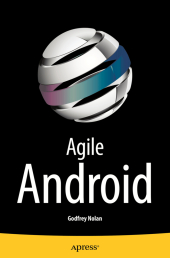 Neuerscheinungen 2015Stand: 2020-02-01 |
Schnellsuche
ISBN/Stichwort/Autor
|
Herderstraße 10
10625 Berlin
Tel.: 030 315 714 16
Fax 030 315 714 14
info@buchspektrum.de |

Godfrey Nolan
Agile Android
1st ed. 2015. xv, 95 S. 59 SW-Abb. 235 mm
Verlag/Jahr: SPRINGER, BERLIN; APRESS 2015
ISBN: 1-484-29700-8 (1484297008)
Neue ISBN: 978-1-484-29700-1 (9781484297001)
Preis und Lieferzeit: Bitte klicken
This concise book walks you through how to get unit testing and test driven development done on Android, specifically using JUnit 4. You´ll learn how to do agile development quickly and correctly, with a significant increase in development efficiency and a reduction in the number of defects.
Agile practices have made major inroads in Java development, however it´s very unusual to see something as basic as unit testing on an Android project. Done correctly, Agile development results in a significant increase in development efficiency and a reduction in the number of defects. Google have finally moved away from JUnit 3 and the developer can now do the more commonly accepted JUnit 4 tests in Android Studio.
Up until now getting JUnit testing up and running in Android was not for the "faint hearted." However, "now it´s in Android Studio, there is no excuse," according to the author Godrey Nolan, president of RIIS LLC. Android developers are faced with their own set of problems such as tightly coupled code, fragmentation, immature testing tools all of which can be solved using existing Agile tools and techniques that this short book will teach you.
What You´ll Learn:
What are the primary agile learning objectives applicable to Android
What are the key Android unit testing tools and how to use them
What is mock testing and the mock testing learning objectives and how to apply these to your Android apps
How to use dependency injection
How to apply test driven development to Android
How to deal with legacy code, a big issue with regards to Android
Audience:
This book is for experienced Android app developers looking for an edge to build better and more agile Android apps. Some experience with Java also helpful.
Lesson 1: Introduction to Agile Learning objectives
1.1 Understand the benefits of using an Agile approach to Android development
1.2 Understand common defects in Android Applications
1.3 Explore the Agile Testing Pyramid for Android
Lesson 2: Android Unit Testing Tools
Learning objectives
2.1 Create Hello World Unit Test in Android
2.2 Run Unit Tests from the command line
2.3 Explore Android Assertions
2.4 Test for common defects in Android Applications
2.5 Setup and Teardown
2.6 Grouping tests
2.7 Adding unit tests to a Twitter client
2.8 Explore more Android Assertions
2.9 Run your tests using Gradle
Lesson 3: Third Party Tools
Learning objectives
3.1: Understand the differ
ence between jUnit3 and jUnit4
3.2: Create jUnit4 Unit Test in Android Studio
3.3: Run code coverage tools in Android
3.4: Test activities on multiple devices using Spoon
3.5: Create an Android project in Github
Lesson 4: Mocking Learning objectives
4.1 Stubs vs test double vs mocking frameworks
4.2 Using a stub to mock out a SQLite database
4.3 Using a test double to mock out a SQLite database
4.4 Using EasyMock to mock out a SQLite database
Lesson 5: Dependency Injection Learning objectives
5.1 Understanding Compile Time Dependency Injection
5.2 Create an Android unit test using
Dagger
5.3 Using Dagger to mock a SQLite databases
Lesson 7: Test Driven Development Learning objectives
7.1 Understanding Test Driven Development
7.2 Writing Testable Code
7.3 Refactoring code
7.4 Writing a Twitter client using TDD
Lesson 8: Dealing with Legacy Code Learning objectives
8.1 Applying TDD to an Existing Project
8.2 Ring Fence Existing Project
8.3 Refactoring Existing Code to increase Code Coverage
Godfrey Nolan is president of RIIS LLC, where he specializes in website optimization. He has written numerous articles for magazines and newspapers in the United States, the United Kingdom, and Ireland. Nolan has had a healthy obsession with reverse engineering bytecode since he wrote Decompile Once, Run Anywhere, which first appeared in Web Techniques in September 1997.


